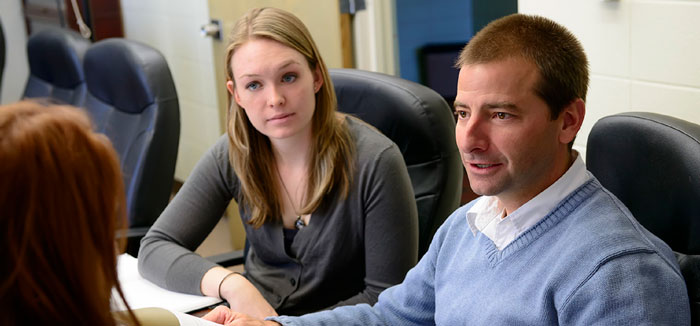Wyoming Trauma Telehealth Treatment Clinic
- Need: To provide psychotherapy to survivors of domestic violence and sexual assault.
- Intervention: University of Wyoming psychology doctoral students provide psychotherapy via videoconferencing to crisis center clients in two rural locations.
- Results: Clients, student therapists, and crisis center staff were satisfied with the quality of services, and clients reported reduced symptoms of depression and PTSD.
Evidence-level
Effective (About evidence-level criteria)Description
Domestic violence and other crimes like sexual assault can cause survivors to experience depression, post-traumatic stress disorder (PTSD), and other mental health conditions. Rural survivors face significant barriers in seeking treatment for these conditions.
The Wyoming Trauma Telehealth Treatment Clinic (WTTTC) uses videoconferencing to connect survivors of domestic violence and sexual assault to psychology doctoral students. The students gain valuable experience, while the patients receive needed therapy. Therapy sessions are free for clients.
The University of Wyoming-based clinic currently has two rural sites:
- Gillette Abuse Refuge Foundation in Gillette, WY
- Carbon County C.O.V.E. in Rawlins, WY
Services offered
Survivors of domestic violence, sexual assault, and other violent crimes can access free psychotherapy services via secure, encrypted videoconferencing technology. Doctoral students who have been trained in trauma intervention theory and techniques provide therapy under the supervision of doctorate-level psychologists. An individual session lasts 60 minutes and occurs weekly.

Before, the sites could only refer clients to counseling services, which were not located onsite. Offering psychotherapy at these safe houses and similar nonprofit organizations allows clients to address immediate, practical needs like emergency housing while at the same time addressing their mental health needs. In addition, this arrangement allows the crisis center staff to initiate a warm handoff between client and student therapist.
Results
In a 2015 study, 21 participants (including clients, therapists, and crisis center staff) rated different aspects like "ease of equipment use" and "sensitivity of therapist" on a 1-5 scale. The lowest score was a 4 from the crisis center staff for "ease of technology use," while the highest score was a 5 from the crisis center staff for "quality of staff interactions with therapists." The clients themselves ranked the overall quality of services a 4.81 out of 5.
Clients completed a questionnaire to measure the presence and severity of PTSD symptoms. The 2015 study showed that the mean score from this questionnaire decreased from 54.43 pre-treatment to 34.10 post-treatment, showing an improvement in PTSD symptoms.
Clients also completed a self-report measuring depression symptoms. The mean score from this report decreased from 29.33 pre-treatment to 15.24 post-treatment, showing an improvement in depression symptoms.
For more information about program results:
Gray, M.J., Hassija, C.M., Jaconis, M., Barrett, C., Zheng, P., Steinmetz, S., & James, T. (2015). Provision of Evidence-Based Therapies to Rural Survivors of Domestic Violence and Sexual Assault via Telehealth: Treatment Outcomes and Clinical Training Benefits. Training and Education in Professional Psychology, 9(3), 235-41. Article Abstract
Hassija, C. & Gray, M.J. (2011). The Effectiveness and Feasibility of Videoconferencing Technology to Provide Evidence-Based Treatment to Rural Domestic Violence and Sexual Assault Populations. Telemedicine Journal and e-Health, 17(4), 309-15. Article Abstract
Challenges
Sites will need a high-speed internet connection to run the videoconferencing technology. This may be a barrier in some rural communities.
Program coordinators would like to expand their services to other domestic violence and sexual assault agencies but say it could be difficult to secure funding for more therapists. The team currently has 3 to 5 therapists. With a graduate assistantship or other funding, the team could offer more therapist hours and have a broader reach.
Replication
Program coordinators report that this is a relatively low-cost program: The only costs include an initial purchase of equipment and funding for the therapists. And, since the sessions are free for clients, there's no hassle with billing. In general, connecting university mental health training clinics with underserved populations using telehealth can be a symbiotic relationship – providing more training opportunities for students and meeting treatment needs of clients who otherwise may not be able to access care.
Contact Information
Matt J. Gray, PhD, ProfessorUniversity of Wyoming Department of Psychology
307.766.2927
gray@uwyo.edu
Topics
Abuse and violence
· Behavioral health workforce
· Health workforce education and training
· Mental health
· Mental health conditions
· Telehealth
States served
Wyoming
Date added
January 2, 2018
Suggested citation: Rural Health Information Hub, 2025 . Wyoming Trauma Telehealth Treatment Clinic [online]. Rural Health Information Hub. Available at: https://www.ruralhealthinfo.org/project-examples/998 [Accessed 16 December 2025]
Please contact the models and innovations contact directly for the most complete and current information about this program. Summaries of models and innovations are provided by RHIhub for your convenience. The programs described are not endorsed by RHIhub or by the Federal Office of Rural Health Policy. Each rural community should consider whether a particular project or approach is a good match for their community’s needs and capacity. While it is sometimes possible to adapt program components to match your resources, keep in mind that changes to the program design may impact results.
